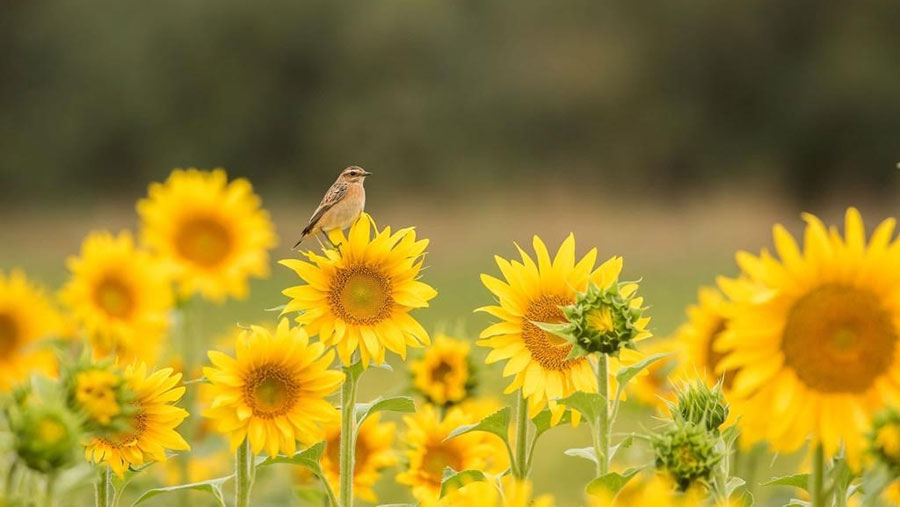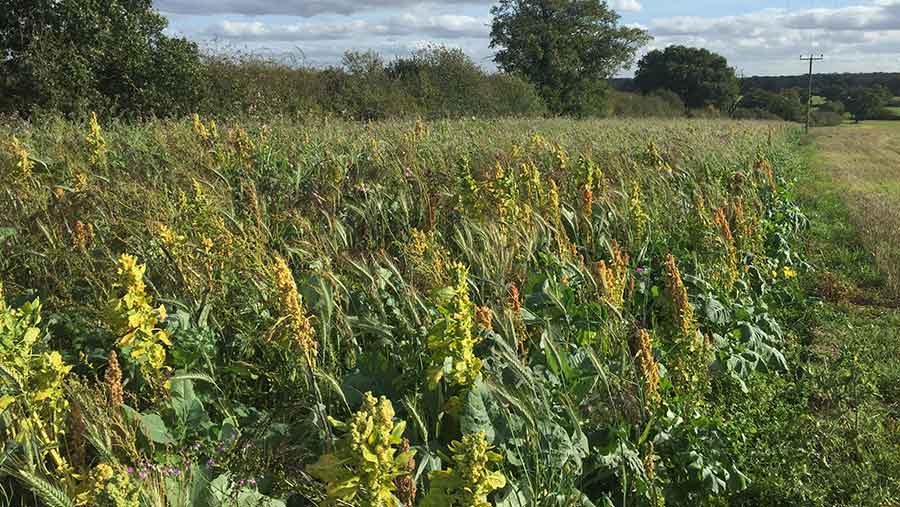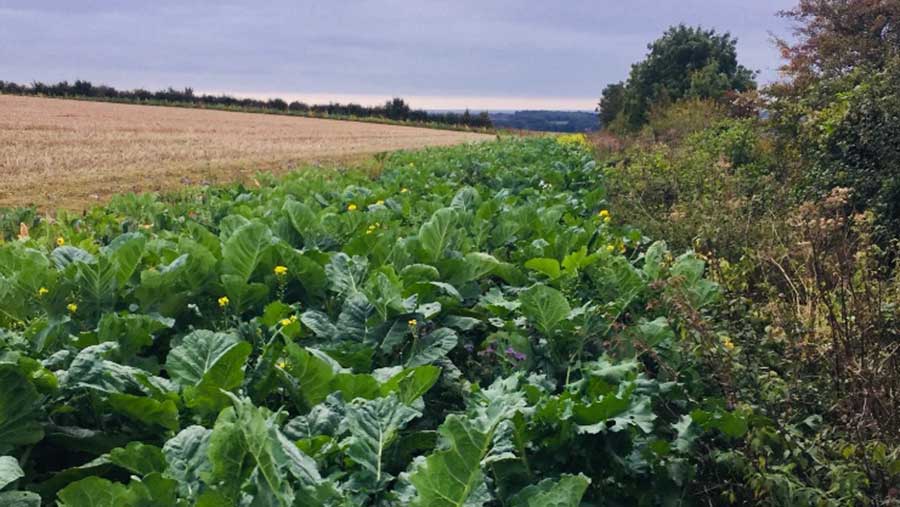Advertiser content
Making a success of your winter bird food mixtures
 Winter bird food plots provide habitat and food for a range of farmland birds, including this whinchat © Bright Seeds
Winter bird food plots provide habitat and food for a range of farmland birds, including this whinchat © Bright Seeds With so many growers now opting for wild bird mixtures, Arthur Barraclough, director at Bright Seeds, looks at how to optimise these plots – which provide benefits for both wildlife and the farmer’s pocket.
Under Countryside Stewardship and the Sustainable Farming Incentive (SFI), specifications can cause limitations across many options.
Luckily, this is not the case when it comes to winter bird food plots, where the options are endless.
Here, the seed mixture used can be tailored towards individual farm requirements, based on each farm’s specific criteria.
With so much to consider, below is an outline of some of the main factors to consider when choosing a mixture and establishing the all-important crop.
With winter bird food plots providing a great opportunity to hugely boost the biodiversity of the farm, it is wise to do everything in our power to produce a successful crop.
Depending on the scheme, a winter bird food plot will be classified as either AB9, AHL2 or CAHL2, and currently paying £853 per hectare.
The requirement for all of the classifications is similar, with the main remit being to include six seed-bearing crops within the seed mixture.
It’s no surprise that the main objective is to supply a feed source for farmland birds during the winter months.
The so-called ‘hungry-gap’ runs from December until March and is the time when wild food is scarce, so stewardship options can create a positive impact on farmland birds.
In addition to supplying grain, the new SFI criteria demands that the crop also supplies flowering species throughout the summer to help pollinators.
This is a sensible overlap, with many crops such as linseed, mustard and fodder radish presenting a bloom of flowers before setting seed for the winter.
Location and soil type
The majority of winter bird food components will grow well across the whole of the UK, with the main exception being sorghum, which prefers warmer climates – so generally speaking is best suited to southern England.
In this sense, millet is similar to sorghum, although Japanese reed millet does differ and is a great option for areas further north.
In challenging growing areas where average temperatures are likely to be lower, brassicas are a good starting point.
Cereals are also a good option, and we tend to use triticale, a wheat/rye hybrid, which is vigorous to establish and also stands very well into the winter.
With regard to soil type, certain crop options will be better suited than others.
On free-draining soils that are prone to drought, chicory and sorghum are two stand-out options.
Chicory is particularly effective due to its long tap root which pushes down into the ground water.
Heavier soil types can be more challenging and, in the spring, can shift from being wet and unworkable to too dry in a short space of time.
To counter this, it is advisable to work the ground over early, giving it time to weather down and preventing the need to rework it before planting, as this can lose moisture.
Another popular option is to plough, then work down, then drill in quick succession, which helps to bring the moisture to the surface.
Weed burden
Traditionally, wild-bird mixtures have been grown on the same plot for many years, and this can lead to issues with weed build-up.
As mentioned, there are numerous combinations for seed mixtures, and this means that they can be designed to enable selective herbicides to be used.
Broad spectrum mixtures generally aren’t well suited to herbicide application, so instead, a well thought out mix containing species from the same crop family will work far better.
For example, if grass weeds are the main issue, then a mix containing predominantly brassicas will work well, along with linseed, sunflowers, gold of pleasure and chicory.
Such a mix can be sprayed with a graminicide to control grass weeds post-emergent.
On the other hand, if broad-leaf weeds like fat hen and redshank are more problematic, then a mix containing grain producers will be better from a herbicide perspective.
Crops like sorghum, millet and cereals are a great starting point if you anticipate that broad-leaf weed control will be needed in the growing crop.
Another good option for creating a weed-free plot is to drill the mixture later.
This works well in organic situations too, as herbicide use is not essential.
The idea is to get the seed-bed prepared to encourage weed seeds to germinate, which can then be sprayed off with glyphosate.
Alternatively, the ground can be lightly cultivated again to kill the young weed plants.
After this, the chosen winter bird food mix can be planted.
Most mixtures can be planted well into June, and we have options for even later planting dates if required.
SFI guidance advises planting before the end of June to ensure the crop is producing seed ready for the winter, so this should be the aim.
Most winter bird food mixtures work best drilled between mid-May and Mid-June.

The winter bird food option provides a great opportunity to boost biodiversity on the farm © Bright Seeds
Establishment
There are a range of tactics for establishing a successful winter bird food plot.
Traditionally, ploughing followed by a power harrow then drill was a standard approach, followed by rolling to ensure good seed-to-soil contact.
This method remains very common and produces great results.
The main consideration is to avoid losing too much moisture before drilling, which can happen if it is ploughed and then left for too long.
Many arable farms have shifted to min-till, strip tillage and direct-drilling systems, and this can work well for stewardship crop establishment too.
In the same way as the mainstream cash crops, direct drilling-based establishment reduces the need for multiple passes and reduces moisture loss from repeat cultivations.
One concern is soil compaction; however, biannual subsoiling can help reduce this without the need to plough.
Fertilising the crop is often overlooked, but it is essential to ensure the seed mixture reaches its full potential.
A lot depends on the chosen mix, but in an ideal world the crop will need 50 – 100kg nitrogen/hectare, plus phosphate and potash.
A compound blend such as 20.10.10 applied at 250 – 500kg/hectare is a good starting point for budgeting fertiliser requirements.
Pest pressure
Flea beetle pressure is certainly not going away and, with the loss of neonicitinoid seed treatments, kale establishment has become more challenging.
This isn’t ideal, with kale forming the basis for most two-year wild bird mixtures.
Fortunately, we now have many hybrid brassicas which look like kale but establish far quicker, meaning that they spend less time at the vulnerable cotyledon stage.
Hares are another common culprit for crop damage.
To neutralise this, Sorghum is a great choice within a mixture as it is toxic during the early growing stage, so it is rarely eaten by hares and deer.
Mustard is another good option, as too is Utopia which is a winter-hardy kale/mustard hybrid.
Product focus
Save our Songbird Mix
We have trialled this mix for a number of years before launching it in 2024. It has proven extremely popular, particularly for larger areas of SFI cropping.
The components are all fast-growing and small-seeded. Red millet, white millet, gold of pleasure, buckwheat, fodder radish, quinoa and mustard.
The mix is economic to buy, simple to establish, and it is well suited to direct-drilling or even broadcasting.
The seed yield is very high, and we’ve found the food supply is nicely staggered from the autumn right through to early spring.
Grass Buster
Grass Buster is a high-specification two-year option, consisting mainly of hardy brassicas.
The mix contains kale, utopia, mustard, fodder radish, forage rape, phacelia, linseed and gold of pleasure.
The large inclusion of annual brassicas helps to nurse the kale along, and we’ve found that this mix produces a great crop which can be left for two years.
The other benefit of Grass Buster is the fact that it can be sprayed with a graminicide post-emergent to control any problem grass weeds, including barn-yard millet and cereal volunteers.
It also has a wide planting window running from May – July. Drilling can be delayed until weather conditions are favourable or until a stale seed-bed has been achieved.

Grass Buster is a popular mix due to its wide planting window and fast establishment. The crop can be sprayed with a selective herbicide to kill grass weeds if required © Bright Seeds
Early Bird
A mainly cereal-based mix which works nicely within an arable rotation, mainly because it can be drilled at the same time as spring cereals.
The mix contains spring triticale, spring barley, spring wheat, spring oats, linseed and buckwheat.
So, wherever you are in the UK, Bright Seeds is on hand to help you choose the right wild bird mixture for you and your farm.
We have several popular mixtures, as shown above, and also have the capability to put together bespoke mixtures for those who require them.
Bright Seeds also supplies seed for the full range of stewardship and SFI options. The team can be contacted on 01722744494 or sales@brightseeds.co.uk

© Bright Seeds
Provided by
With The Environmental Land Management Scheme (ELM) and The Sustainable Farming Incentive (SFI), British Farming is, arguably, undergoing the biggest transformation since the end of World War II.
For this approach, to a more environmental way of farming, to be successful, stakeholders from across the board must be trusted, reliable and dependable.
At Bright Seeds, we have supplied industry leading stewardship and cover crop seed to farms for over 30 years, with many of our game cover mixtures making the transition to ELMs and SFI seamlessly.
As long-standing partners to British Farmers and their environmental requirements, we feel pleased and privileged to be a part of a transition movement both with the Farmers Weekly, and the broader industry.
For any advice on your ELMs, SFI or cover crop requirements, please don’t hesitate to call our team on 01722 744494, or email us at sales@brightseeds.co.uk
